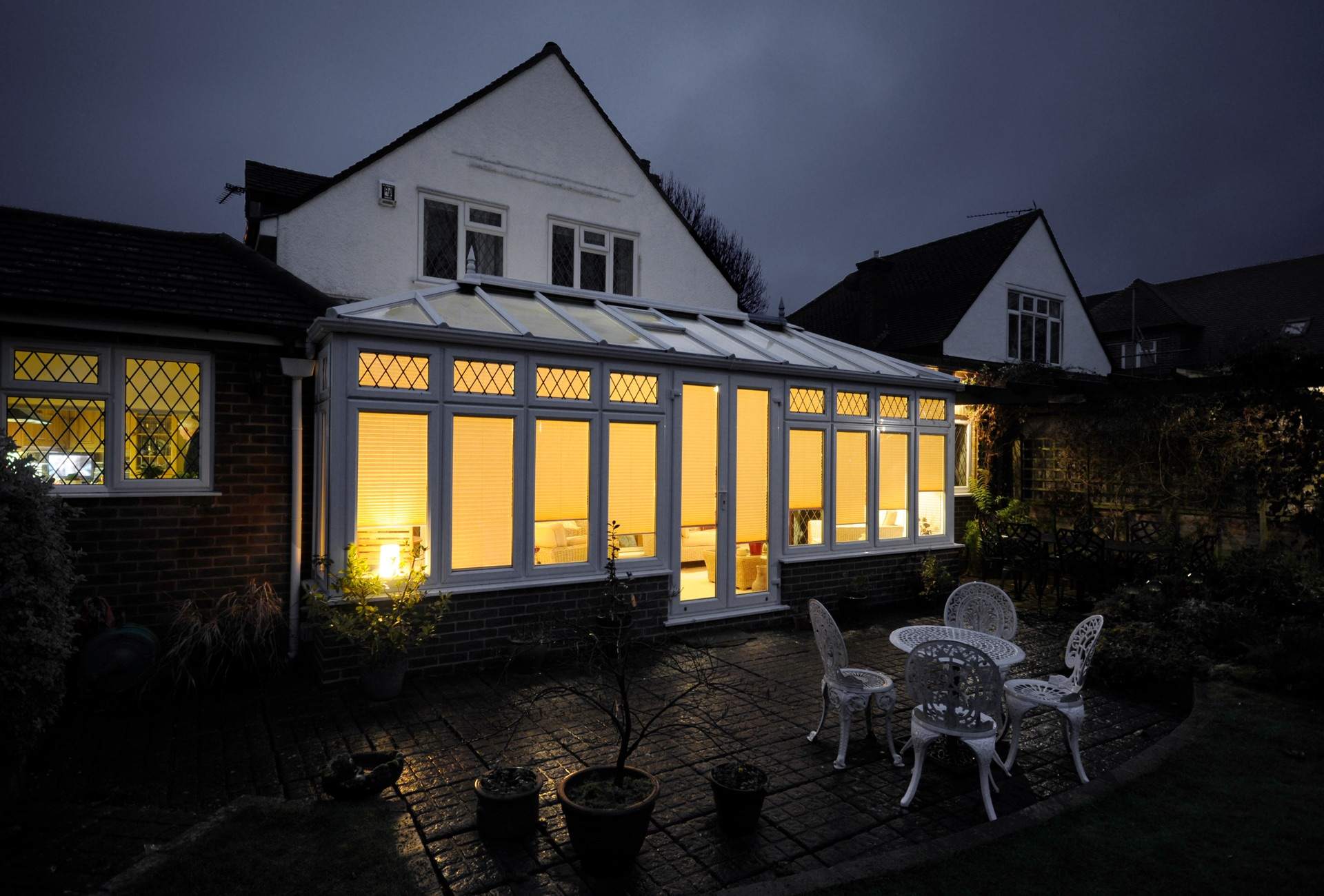CONSERVATORY – FREQUENTLY ASKED QUESTIONS
Click the questions to view the answers.
The short answer is no; in the vast majority of situations it is possible to fit blinds to a conservatory and still have its guarantee intact. However that doesn’t mean that every method of fitting blinds will be safe, and it’s something you need to watch out for when getting a quotation from different companies.
Some conservatory manufacturers specify that we only use an individual blind layout with a small air gap either side of the blind so that heat doesn’t build up between the blind and the glass and potentially cause damage. This is not a problem for us, as we usually recommend an individual layout anyway, but some companies will always quote for a doubled-up blind layout as it usually works out cheaper – even if it would void the guarantee of the conservatory.
We recommend to all customers that are worried that blinds might cause problems with their conservatory’s guarantee to contact their conservatory company and see what they recommend. Then, when they have quotations for blinds, make sure what’s being quoted actually conforms with these guidelines and isn’t just the cheapest option.
Another point to consider is that there are hundreds of thousands of conservatories with blinds already fitted in them and, in many cases, the conservatory builders themselves actually recommend specific blind companies to buy from (in most cases they earn a sales commission).
As a final reassurance, bear in mind that there are specific types of conservatory blinds (not just any old blinds, but conservatory blinds) that are purpose-designed for the job in hand. This would not be possible if blinds could not be fitted in conservatories.
Any conservatory can have blinds installed without affecting the guarantee (otherwise it would not be fit for purpose under the Consumer Regulations 2015) but it does depend on whether the blinds are suitable for the use you have intended, that the fabric is not going to adversely affect the glazing and that the blinds have been installed correctly, avoiding any damage to the integrity of the structure.
We have been fitting conservatory blinds to solar glass conservatory roofs since they first started becoming popular in 2007. In fact, many of the pictures on this web site and in our Image Gallery are of conservatories with solar glazing.
Glass technology has greatly advanced in recent years, and you can now buy glass roofs that are much more efficient at keeping in heat and reducing solar gain. However, any type of glass (even solar glass) is still an inefficient material compared to the rest of your home.
You may have been told that, if you by solar glass, you “won’t need blinds” but these kinds of verbal comments are, at best, misleading – and often completely untrue.
Conservatory blinds can significantly improve the thermal resistance of any tinted glass, solar glazing or polycarbonate roof and transform your conservatory.
Genuine conservatory blinds help to maintain a more balanced temperature, day or night, rain or shine, irrespective of your glass. Blinds also provide privacy, help to block out an unattractive view, offer UV protection, reduce glare and create a more welcoming atmosphere.
Most people who have been told that they won’t need blinds only buy window blinds first, because they want to create privacy and windows aren’t tinted. Often on the day of installation, customers then decide to also then order roof blinds as well, even though this is normally more expensive because it requires an additional visit.
Highly reflective fabrics are NOT advised for tinted or solar glass roofs. The quality of fabric is also important to help retain a relatively high degree of natural light (otherwise it will be very dark) which precludes cheap low-tech fabrics.
Conservatory Blinds Ltd are one of only a few conservatory blinds specialists who not only have suitable fabrics to improve insulation, but have the experience to know when and where they are best suited – especially when dealing with solar glazing.
Yes, we have a number of conservatory blinds ranges that can be fitted to most conservatory windows so that they look like part of the structure, rather than a cumbersome afterthought.
Our pure™ technology normally offers the best solution for recessed window blinds using our pure™ pleated blinds.
Eos pleated blinds are another purpose-designed range of pleated blinds.
Anglian conservatory blinds – which blinds do we recommend in an Anglian conservatory?
Although a frequently asked question, there are many possible blinds that would be recommended in an Anglian conservatory depending on size, shape, age and complexity, as well as budget.
Certainly the most popular blinds in an Anglian conservatory would be Eos pleated blinds with solar reflective Crush fabrics (find out more by reading the section below).
Anglian conservatory roofs are actually manufactured by Ultraframe, whose guarantee requires that each roof blind does not cover more than one pane of glass, also allowing a 15mm air gap around the edge of the blind. This is because some blinds are inappropriate and create a huge heat build-up between the blind and the fabric that could potentially damage the conservatory.
Anglian conservatories have different shaped glazing beads on the windows which very much lend themselves to our exclusive pure™ pleated blinds.
Current Anglian conservatories also have slightly deeper glazing bars (rafters) and integrated ventilators at the eaves which again normally lead us to suggest pure™ pleated roof blinds.
The mouldings used in Anglian conservatories around the fascia (in corners and at junctions) can require some blind types to be fitted too high, but this can be avoided using pure™ pleated blinds.
For genuine expert advice contact us for a free quotation.
Everest conservatory blinds are available in a wide variety of types and ranges to suit your specific budget and taste.
Generally speaking Eos pleated blinds and pure™ pleated blinds are the most popular choice in an Everest conservatory and more often than not they are the technically superior choice, however this can vary with shape, size, complexity and budget.
An Everest conservatory can also be suited to our range of pure™ Pinoleum Blinds, particularly gable end conservatories which often appear particularly stunning.
For the best advice and recommendations for your Everest conservatory blinds please contact us for a free quotation.
Amdega conservatory blinds are larger than many others. Amdega conservatories have approx. 1400mm wide sections (nearly 5′) subdivided into 3 narrower sections and so can have very different blind layouts, which in turn affects which blinds that we recommend.
The most popular Amdega conservatory blinds are pure™ Pinoleum Blinds with big blinds spanning the 1400mm width fitted onto the fascia at the eaves and within the top of the main rafters at the top with a semi-recessed installation.
On roof vents we recommend separate blinds so that the roof can be ventilated and yet you can retain the shade and insulation all year round.
Our pure™ Pleated Blinds are also an option with this type of layout and we have developed a special pleated blind especially for Amdega conservatories. Pleated blinds can even be individually recess-fitted for a completely integrated appearance – the difference between the blind layouts is quite dramatic.
If considering pleated blinds we would recommend pure™ Pleated Blinds, although if small gaps are not an issue then Standard pleated blinds are also worth considering.
Finally, our unique puresolo™ remote control system is available with pure™ Pleated and Pinoleum Blinds for Amdega conservatories.
Synseal are one of the most popular manufacturers of conservatories in the UK with many regional and local conservatory builders specifying Synseal conservatories.
Synseal conservatories are unusual because they provide all of the roof, windows, doors and trims from one source and so the conservatories fit well, have the same colour and the mouldings tend to respect the shape of the conservatory. This makes it much easier for our blinds to be installed neatly without the need for cut-outs or infill blinds.
The aluminium roof bars are ideal for a safe installation of purpose-designed roof blinds and the internal neoprene gasket seals means that Perfect Fit blinds cannot be installed.
Many Synseal conservatories have woodgrain finishes which contrast well with our range of 6 standard colours of rails.
We recommend pure™ Pleated Blinds and our unique pure™ Pinoleum Blinds for most Synseal conservatories.
Conservatory Blinds Limited is not associated with Synseal Extrusions Ltd.
Our pure™ Pinoleum Blinds are the most popular for timber conservatories, however we also install many pure pleated blinds as well. For window shading we have also noticed that some people also consider roller blinds.
UPVC conservatories are extremely popular and make up the vast majority of all conservatories built in the UK.
There are many different roof systems, glazing types and profiles used by conservatory builders and as tastes and budgets vary, there is no single blind range that can be recommended in all situations.
As a general rule of thumb, pleated blinds are the most popular and there are two different pleated blind ranges that are actually purpose-designed for modern UPVC conservatories; Eos pleated blinds and pure™ Pleated Blinds.
Roof blinds are normally surface-mounted on the rafters with window blinds often recess-fitted to the glazing beads, creating a truly built-in appearance.
Some UPVC conservatories have decorative mouldings that can hinder the installation of some blinds, but purpose-designed conservatory blinds have special mounting profiles and alternative fittings that can overcome these problems without leaving gaps or causing damage.
Other pleated blinds are also available, but they are general blind systems that do not fit quite as neatly, and in some cases can be sub-standard.
Our unique pure™ Pinoleum Blinds can also be suitable in a UPVC conservatory as they benefit from the same purpose-designed operating system.
Because window handles project out from UPVC windows, any surface-fitted blinds, such as roller blinds, vertical blinds and venetian blinds need to be fitted very closely together (so blinds that required cleats would not be recommended).
If considering vertical blinds then ensure that they are fitted sufficiently away from the roof so that any roof blinds can also be subsequently installed.
Perfect Fit blinds are available, and whilst not being actual “conservatory blinds” they can be easily fitted into many UPVC windows providing a good DIY option, especially if only needing a few blinds at a time.
Although UPVC conservatories are actually made from aluminium, here we are referring to plain aluminium conservatories that generally have much thinner sections than their counterparts on the continent.
Aluminium conservatories are quite unusual in the UK and normally have narrower/shallower glazing bars and frame sections. This actually makes them much harder to fit to and means that there is very little room for error.
Because aluminium conservatories require much more precise fitting blinds we normally recommend pure™ Pleated Blinds for both roof blinds and window blinds because the blind rails can be fitted to any type/shape of frame/bead.
In some cases we also recommend pure™ Pinoleum Blinds because they incorporate the same type of rails and operating system, although these blinds entail surface-mounted freehanging window blinds.
Some aluminium conservatories have much deeper beamed rafters, in which case the possible choice for roof blinds is much greater.
Lean-to conservatories with completely rectangular glazing normally offer the widest choice of blinds available as there are fewer discerning factors between ranges other than colour and prices.
If your lean-to conservatory is quite low or is not perfectly rectangular (perhaps due to brick piers, pipes or just that the rafters are not perfectly aligned) then surface-mounted pleated blinds are recommended.
Depending on fabric, attention to detail, washability and budget you could choose from:
- Duette® pleated blinds
- pure™ pleated blinds
- Budget pleated blinds
- Standard pleated blinds
- Eos pleated blinds
If your lean-to conservatory has shaped glazing on the sides (where the sloping roof meets the side windows) then you may also need shaped blinds in which case this would refine our pleated blind recommendations down to Eos pleated blinds or more likely just pure™ Pleated Blinds (as the shaped blinds can be recess-fitted and are easy to maintain).
If you have a timber conservatory then pure™ Pinoleum Blinds are very popular, but ensure that your rafters are perfectly straight and don’t taper or twist as this will result in unsightly gaps between the straight edge of the blinds and the “wavy” edge of the rafters.
Some lean-to conservatories have Ultralite or tinted polycarbonate roofs which change the colour of the light coming into the conservatory. We can recommend different fabrics that will not darken your conservatory or be so highly reflective as to damage the polycarbonate.
Full height window glazing in a lean-to conservatory can sometimes be suited to vertical blinds, although this very much depends on the proposed usage and budget.
A final point worthy of note is that Lean-to conservatories are unique in as much as the roof blinds will cost less than the side blinds because there is proportionally less glazing on the roof – but this also means that the windows are also more likely to allow a greater degree of heat in and out.
Try our interactive guide to selecting conservatory blinds, compare conservatory blinds ranges or just visit our image gallery.
Pilkington created K-Glass® as a ground-breaking form of glazing that helps save energy by significantly reducing the heat loss like normal double-glazing. It is now the most popular choice for window glazing because it helps to improve the U-value of a conservatory.
Whilst it is not a requirement in a separate conservatory, it is still commonly specified (open plan conservatories will still need to meet the required U-values).
Genuine conservatory blinds will improve the performance of K-Glass as it does not reduce solar gain heat build-up created by the sun and still allows conservatories to significantly lose heat through the large amount of glass (compared to a house).
Whilst we would advise against highly reflective laminated fabrics such as some pleated blinds, roller blinds and venetian blinds, all of our purpose-designed conservatory blinds (such as pure™ Pleated Blinds, Eos pleated blinds and pure™ Pinoleum Blinds) are safe to use with K-Glass (or any form of E-Glazing).
For specific advice about which conservatory blinds will suit your requirements, please contact us.
We offer a range of horizontal blinds specially designed to be used for a lantern roof, that allow you to cover the area with just a small amount of blinds. For these style of blinds we usually recommend Duette® fabrics or the single-pleat Solar Design fabrics we use with our pure™ Pleated Blinds.
If you’re looking for an individual layout, we generally recommend the same blinds for lantern roofs as we do for normal conservatory roofs: Our pure™ Pleated Blinds , Duette® Blinds or our pure™ Pinoleum Blinds, depending on your own personal preference.
If your conservatory has a polycarbonate roof then you will probably have realised how noisy it can be, especially when it is windy, raining or hailing. You may also notice a reduction in natural light making it a concern if considering blinds.
We can help guide you to a suitable blind system and range of fabrics that will not adversely affect your roof (especially if you have an Ultralite roof) so that you will retain a good level of natural light.
If you just want to improve the noise insulation then conservatory roof blinds are an ideal solution, and depending upon the shape and use of the conservatory we normally recommend Duette® pleated blinds, pure™ Pinoleum Blinds or Budget pleated blinds (avoiding certain highly reflective fabrics).
We are highly experienced in recommending and installing the right blinds with the correct layout and with professional fittings in Ultraframe conservatory roofs so that you can still make the most of these technically advanced features, rather than smothering them with bulky blinds and low-tech fabrics.
Most blind ranges can be fitted to Ultraframe conservatory roofs to varying degrees of performance and suitability, but by far the most popular ranges are our pure™ pleated blinds and the Duette® Pleated fabrics.
Ultraframe conservatory roofs tend to have very shallow angles with narrow tops required for shaped blinds, as well as mouldings fitted to the eaves. The ridge and central boss cappings require mounting profile and small infill blinds to create a truly fitted appearance making them less suited to standard pleated blinds or Perfect Fit.
Contact us for expert advice and a wide choice of conservatory blind quotations.
Vale Garden Houses rank among the very highest quality conservatories available and so it is vital that you receive the very best advice with your conservatory blinds. We have fitted our blinds into many Vale conservatories with stunning results.
Blind layout can vary depending on whether you are looking for larger blinds fitted below the rafters (typical of pinoleum blinds) or individual recessed-fitted blinds (such as pure™ pleated blinds).
Our unique puresolo™ remote control system is designed to offer the neatest installation with a completely concealed low-voltage cable and an easy to use handset that can control all of your blinds together, in groups, or even individually.
The most popular blinds for Vale Garden House conservatories are our real wood pure™ Pinoleum Blinds.
Conservatory Blinds Limited is not associated with Vale Garden Houses Ltd.
Gable End conservatories present slightly different challenges from simpler shaped conservatories when recommending blinds.
The roof pitch on a Gable End conservatory is normally slightly steeper and so motorised blinds with remote control operation, or manual blinds with adjustable handles are far more practical.
Also, because of the roof pitch, pinoleum blinds lay flatter at the top making the fabric more pronounced at the base, creating a very impressive appearance.
Pleated blinds are also very popular and unlike other blinds can be operational in the triangle formed by the gable. Our pure™ pleated blinds have a motorised option that can completely retract without any visible wires or cords – leaving clear glazing.
Click here to find out more about our unique pureaspect™ gable blinds for people who want their blinds to completely retract with no wires or cables across the glass.
A high proportion of modern conservatories are shaped – and not just the standard shapes – they include obtuse angles (triangles that lean back on themselves) diamond shaped panes of glass, and even glazing with box gutters intersecting them.
For the neatest fitting blinds in a complex shaped conservatory that don’t look like a cumbersome afterthought we normally recommend pure™ pleated blinds.
Solar Design pleated blinds are purpose-designed for complex conservatories:
- Narrow tops (shaped blinds can be made to 59mm wide tops)
- Slim rails (11mm) that are unobtrusive
- Fabric Control Cording to hold the shape and lay flat when retracted
- Many complex shapes can be made as one blind without infill blinds
- Tension adjusters to account for movement and can be adjusted
- Unique purpose-designed fixing profile for mounting the blinds neatly
- Completely washable to retain their as-new appearance
- Silicone impregnated stainless steel microcables
- Colour coordinated cording (not just white)
- Numerous remote control options







